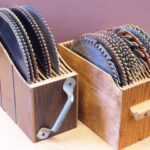Woodworking routers are versatile and powerful tools that are essential for any woodworking project. Whether you are a beginner or an experienced woodworker, understanding the uses and techniques of routers is crucial for creating high-quality and professional-looking woodworking projects.
Routers are used to hollow out an area in a solid surface, typically wood, and they can be used for a variety of tasks such as shaping edges, making grooves, creating joinery, and carving intricate designs. In this article, we will explore the different types of woodworking routers, essential techniques for using them, creative applications in woodworking projects, advantages of using routers, common mistakes to avoid when using them, and safety tips.
We will cover everything from the basic functions of routers to advanced techniques that can elevate your woodworking projects. Whether you are just starting out or looking to expand your skills, this comprehensive guide will provide you with valuable information on how to make the most out of woodworking routers.
Types of Woodworking Routers
Woodworking routers come in a variety of types, each designed for specific tasks and projects. Understanding the different types of routers available is essential for woodworkers looking to enhance their skills and expand their capabilities.
Fixed-Base Routers
Fixed-base routers are very versatile and can be used for a wide range of woodworking tasks. They are designed with a fixed base that offers stability and precision when routing. These routers are ideal for edge profiling, dado cuts, and mortising.
Plunge Routers
Plunge routers are equipped with a spring-loaded base that allows the router bit to move up and down, making it easier to create grooves, flutes, and other intricate designs. Woodworkers often use plunge routers for carving designs into wood or making interior cuts.
CNC Routers
CNC (computer numerical control) routers are a more advanced type of router that is typically used in industrial settings or by experienced woodworkers. These routers are programmed to follow precise patterns or designs, allowing for incredibly accurate cuts and shapes to be created in wood.
Understanding the differences between these types of woodworking routers is crucial for selecting the right tool for the job at hand. Whether you’re performing simple edge profiling or intricate carving, choosing the appropriate router will ensure that your woodworking projects turn out exactly as planned.
Essential Router Techniques in Woodworking
Woodworking routers are versatile and essential tools for any woodworker, allowing them to create intricate designs, make joints, and shape edges with precision. To fully utilize the potential of a woodworking router, it’s important to master essential techniques that will elevate the quality and craftsmanship of your woodworking projects.
Routing Edges
One of the most common uses of a router in woodworking is to shape and detail edges. With the appropriate router bit, woodworkers can create decorative profiles on tabletops, cabinet doors, shelves, or any other piece of furniture. By using a router table or hand-held router, woodworkers can easily achieve smooth and consistent edge profiles that add a professional finish to their projects.
Creating Dado Joints
Another essential technique for woodworking routers is creating dado joints. Dado joints are used to join two pieces of wood together at right angles, providing strong support for shelves in cabinets or bookcases. Routers equipped with straight bits can efficiently cut grooves in the wood that perfectly fit the mating pieces, ensuring a snug and secure joint.
Making Mortise and Tenon Joints
Woodworking routers are also indispensable for creating mortise and tenon joints, which are commonly used in furniture-making. By using a plunge router and a mortising jig or attachment, woodworkers can accurately carve out the mortises on one piece while creating corresponding tenons on another piece. This traditional joinery method ensures stability and longevity in furniture construction.
Mastering these essential techniques will enable woodworkers to fully harness the capabilities of routing in woodworking projects. Understanding how to appropriately use routers for edge detailing, creating strong joints like dado and mortise/tenon joints opens up endless possibilities for crafting high-quality custom furniture pieces with precision and finesse.
Creative Uses for Routers in Woodworking Projects
Woodworking routers are incredibly versatile tools that can be used for a variety of creative purposes in woodworking projects. One of the most common creative uses for routers is for creating intricate and decorative edges on wooden pieces.
This can include creating unique molding designs, adding decorative edges to tabletops, or shaping the edges of cabinet doors. Routers can also be used to create dovetail joints, which are not only strong and durable but also add a beautiful and professional touch to woodworking projects.
Another creative use for routers in woodworking is carving intricate designs and patterns into wood. This can range from simple lettering or numbering on wooden signs to more elaborate designs such as floral patterns or geometric shapes on furniture pieces. By using different router bits and adjusting the speed and depth of the cut, woodworkers can achieve incredible precision and detail in their carved designs.
Routers are also commonly used for inlay work in woodworking projects. Inlay involves cutting out a precise cavity in one piece of wood and then fitting another piece of wood, often a contrasting color or type, into that cavity. Routers make it possible to achieve tight-fitting inlays with clean edges, adding an eye-catching element to furniture, flooring, or other woodworking projects.
| Creative Uses for Routers | Examples |
|---|---|
| Creating decorative edges | Molding designs, tabletop edges, cabinet door shaping |
| Carving intricate designs | Lettering on wooden signs, floral patterns on furniture |
| Inlay work | Furniture accents, flooring design elements |
Advantages of Using Routers in Woodworking
Woodworking routers are incredibly versatile tools that offer a wide range of advantages when used in woodworking projects. One of the main advantages of using routers is their ability to create intricate designs and details in wood, such as decorative edges, dadoes, and rabbets. Routers can also be used for joinery, allowing woodworkers to create strong and precise connections between pieces of wood.
Another advantage of using routers in woodworking is their ability to work with different types of bits, each designed for specific tasks. This means that routers can be used for a variety of cutting and shaping operations, making them indispensable tools in any woodshop. Additionally, modern routers often come with variable speed settings, allowing woodworkers to adjust the tool’s speed according to the type of wood and the specific task at hand.
Furthermore, routers can be utilized for both handheld and table-mounted operations, offering flexibility and convenience in a variety of woodworking projects. Handheld routers are perfect for smaller tasks or when working on irregularly-shaped pieces of wood, while table-mounted routers provide stability and precision for larger projects. Overall, the versatility and precision offered by woodworking routers make them essential tools for any serious woodworker.
| Advantages | Explanation |
|---|---|
| Intricate Designs | Routers can create decorative edges and intricate details in wood. |
| Versatile Bits | Routers can work with different types of bits for a variety of cutting and shaping operations. |
| Handheld or Table-Mounted Operations | Routers offer flexibility with options for both handheld and table-mounted operations. |
Common Mistakes to Avoid When Using Routers in Woodworking
When using routers in woodworking, there are several common mistakes that beginners and even experienced woodworkers can make. It’s important to be aware of these errors to ensure the safety and quality of your woodworking projects. Here are some common mistakes to avoid when using routers:
- Not wearing proper safety gear: One of the most crucial mistakes to avoid when using routers in woodworking is not wearing the necessary safety gear. This includes eye protection, ear protection, and a dust mask. Routers can produce a lot of noise and sawdust, so it’s important to protect yourself from potential hazards.
- Using the wrong router bit: Another common mistake is using the wrong router bit for the task at hand. Different router bits are designed for specific cuts and techniques, so using the wrong one can result in poor quality work or even damage to your project.
- Incorrect router speed: Adjusting the speed of your router is essential for different types of cuts and wood materials. A common mistake is using the wrong speed setting, which can lead to burns on the wood or an uneven finish.
Awareness of these common mistakes will help you become a more proficient user of routers in woodworking and improve the quality of your projects.
In addition, not maintaining and cleaning your router properly can also lead to issues such as reduced performance and shortened tool lifespan. Finally choosing poor quality router bits can result in subpar results so it is important use high-quality bits that are suitable for the specific task at hand. By understanding these potential pitfalls and how to avoid them, you can make sure that you get the best results from your woodworking router projects.
Safety Tips for Using Routers in Woodworking
Woodworking routers are powerful tools that can be extremely useful, but they also come with their own set of dangers. When using a router for woodworking projects, it is important to prioritize safety in order to prevent accidents and injuries. Here are some essential safety tips to keep in mind when using routers for woodworking:
- Wear Protective Gear: Always wear safety goggles or a face shield to protect your eyes from flying wood chips and debris. Additionally, wearing ear protection can help minimize the noise produced by the router, and using a dust mask can prevent inhalation of wood dust.
- Secure Workpiece Properly: Before using a router, make sure that the workpiece is securely clamped or held in place with a non-slip surface. This will prevent the piece from moving or slipping during operation, reducing the risk of accidents.
- Use Push Blocks and Guards: When operating a router, use push blocks or sticks to guide the workpiece through the cutting path instead of relying on your hands. Additionally, always utilize any guards or fences provided with the router to protect your hands from accidental contact with the cutting tool.
These safety tips are just a few examples of how to stay safe when using routers in woodworking projects. By following proper safety protocols and being mindful of potential hazards, woodworkers can ensure they have a safe and productive experience with these versatile tools. Remember, taking precautions when using routers is crucial for preventing accidents and maintaining a safe working environment.
Conclusion and Resources for Woodworking Routers
In conclusion, woodworking routers are versatile and essential tools for any woodworking enthusiast or professional. They come in a variety of types, each with their own unique capabilities and applications. Whether you’re shaping edges, cutting grooves, or creating intricate designs, a router can help you achieve precise and professional results in your woodworking projects.
When using routers in woodworking, it’s important to master essential techniques and be aware of common mistakes to avoid. Taking the time to learn proper safety precautions is also crucial in order to prevent accidents and injuries. By familiarizing yourself with the different types of routers and their advantages, you can make informed decisions on which router is best suited for your specific woodworking needs.
For those interested in learning more about routers for woodworking, there are plenty of resources available, including books, online tutorials, and woodworking communities where you can seek advice and inspiration. With the right knowledge and skills, you can maximize the potential of routers in your woodworking projects and take your craftsmanship to the next level.
Frequently Asked Questions
Do I Really Need a Router for Woodworking?
Yes, a router is an essential tool for woodworking. It is used to hollow out an area in a piece of wood, create decorative edges, and join pieces of wood together. Routers can also be used for shaping and smoothing wood.
What Are 3 Main Functions of a Router?
The three main functions of a router are shaping, cutting, and joining. Routers can be equipped with different bits to create a variety of shapes and edges in wood. They can also be used to cut dadoes, rabbets, and grooves for joinery. Additionally, routers can be used to join pieces of wood together using dovetail or box joint templates.
What Is the Use of a Router?
The primary use of a router is to shape and finish wood. It is commonly used for creating decorative edges on furniture or cabinetry, as well as making precise cuts and joinery in woodworking projects.
Routers are versatile tools that can handle a wide range of tasks such as trimming laminate, cutting grooves for inlays, and even carving intricate designs in wood. Overall, the router is an indispensable tool for any woodworking shop.

Hi everyone! I’m a woodworker and blogger, and this is my woodworking blog. In my blog, I share tips and tricks for woodworkers of all skill levels, as well as project ideas that you can try yourself.





